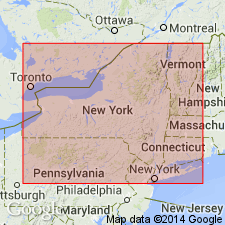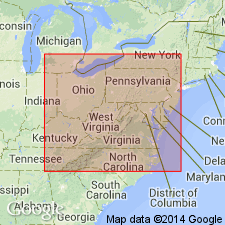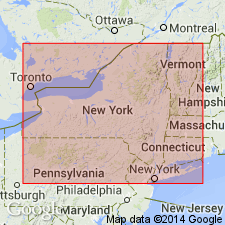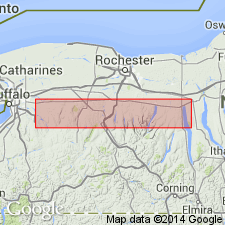
- Usage in publication:
-
- Moscow shales
- Modifications:
-
- Named
- Dominant lithology:
-
- Shale
- AAPG geologic province:
-
- Appalachian basin
Summary:
Named Moscow shales for Moscow, Livingston Co., NY. Fossils and shales change considerably from those below. Chiefly bluish, sometimes olive, and in certain localities portions near upper part are black. Very little of mass is slaty. Unit underlies the Tully limestone and overlies Encrinal limestone. The Moscow is of Middle Devonian age.
Source: GNU records (USGS DDS-6; Reston GNULEX).

- Usage in publication:
-
- Moscow Shale*
- Modifications:
-
- Areal extent
- AAPG geologic province:
-
- Appalachian basin
Summary:
Moscow Shale extended from western NY to western PA and in subsurface to northern WV and western MD.
Source: GNU records (USGS DDS-6; Reston GNULEX).

- Usage in publication:
-
- Moscow Formation
- Modifications:
-
- Revised
- Overview
- AAPG geologic province:
-
- Appalachian basin
Summary:
Uppermost of five major formations in the Hamilton Group. In western NY, consists of gray to black shales, calcareous mudstones and thin limestone. Can be interpreted as a single major depositional sequence, representing 1.5 to 2.0 m.y. of geologic time and bounded above and below by angular unconformities. Lower portion according to authors "might be termed Portland Point subformation" and consists of the Tichenor, Deep Run, Menteth and Kashong Members. In the Cayuga Lake region and in Erie Co., members thin abruptly and merge into a thin limestone-rich interval previously termed the Portland Point Member. The upper, thicker portion of the Moscow consists of the Windom Shale Member in western NY and the Cooperstown Siltstone Member in central NY. In the Finger Lakes region another thin, silty, fossil-rich interval intervenes between the Kashong and the Windom and is here informally termed the "unnamed member." The unnamed member consists primarily of shales and thin concretionary limestone in western areas, but eastward can be subdivided into coarsening-upward mudstone to siltstone packages. The unnamed member extends from Hamilton in the Chenango Valley to just west of Bristol Valley where it is absent due to erosional truncation. It includes the informally named Barnes Gully bed at its base, MEGASTROPHIA beds, Curtice Road bed, and Geer Road bed. Between the Curtice Road and Geer Road beds is a 3-m-thick interval referred to as LONGISPINA-MUCROSPIRIFER shales. Age of the Moscow is Middle Devonian (Givetian).
Source: GNU records (USGS DDS-6; Reston GNULEX).

- Usage in publication:
-
- Moscow Formation
- Modifications:
-
- Overview
- AAPG geologic province:
-
- Appalachian basin
Summary:
Lowermost 50 m of the Moscow Formation in the Schoharie Creek and Valenti Road Sections is composed of gray mudstone interbedded with sandstone sets that vary in thickness from 1 cm to 1 m and contain small and medium-scale cross-strata and ripple marks. All strata is burrowed. The lowest 20 m is mudstone dominated and contains marine shelly fossils and quartz pebbles. The middle Moscow is composed of two 35-m-thick sandstone-dominated sequences, parts of which are exposed in this area. A mudstone-rich interval splits the two sandstone sequences. The upper Moscow is predominantly red and gray-green mudstone. The 130-m-thick lower to middle Moscow represents a regressive shoreline sequence on which three smaller-scale regressive sequences are superposed. In this area, the Moscow includes the lower Portland Point Member and the overlying Cooperstown Member. Overlies the Panther Mountain Formation and underlies the Gilboa Formation. Grades eastward into the Manorkill Formation. Age is Middle Devonian. Emphasis of article is on depositional environment.
Source: GNU records (USGS DDS-6; Reston GNULEX).

- Usage in publication:
-
- Moscow Formation*
- Modifications:
-
- Overview
- AAPG geologic province:
-
- Appalachian basin
Summary:
Following usage of Baird (1979), Moscow Formation in central NY contains (ascending) Tichenor Limestone Member, Deep Run Shale Member, Menteth Limestone Member, Kashong Shale Member, Windom Shale Member. Overlies Ludlowville Formation.
Source: GNU records (USGS DDS-6; Reston GNULEX).
For more information, please contact Nancy Stamm, Geologic Names Committee Secretary.
Asterisk (*) indicates published by U.S. Geological Survey authors.
"No current usage" (†) implies that a name has been abandoned or has fallen into disuse. Former usage and, if known, replacement name given in parentheses ( ).
Slash (/) indicates name conflicts with nomenclatural guidelines (CSN, 1933; ACSN, 1961, 1970; NACSN, 1983, 2005, 2021). May be explained within brackets ([ ]).

